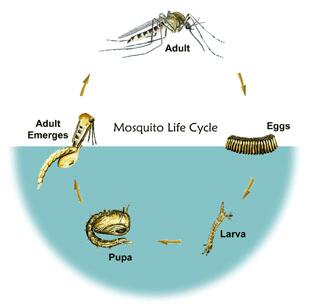Mosquito Biology
Mosquitoes are two-winged flies that belong to the family Culicidae in the order Diptera. There are approximately 3,500 species of mosquitoes. The family Culicidae is divided into three subfamilies: Toxorhynchitinae, Anophelinae, and Culicinae. Worldwide, there are 37 genera of mosquitoes. Mosquitoes live in humid tropics and subtropics, warm moist climates, temperate and cool zones -- everywhere except areas that are permanently frozen.
 Mosquito Egg Biology
Mosquito Egg Biology
Mosquito eggs can be characterized by two major types: floodwater and permanent water eggs. The females of floodwater species will lay their eggs on a moist substrate, not on standing water. It is a requirement that their eggs dry out for a period of time before they will become viable. Once they have passed through the critical drying time, they may hatch if the area is flooded by rain or by high tides. Permanent water mosquito eggs are laid on the water surface, either singly, or in a raft containing up to 300 eggs. The permanent water eggs cannot survive if they dry out, and therefore, must be laid in a fairly permanent source of water such as a lake or swamp. The eggs of permanent water species will hatch within about 24 hours.
Larval Mosquito Biology
The larval stage of the mosquito is aquatic. The larvae are legless and spend a majority of time at the surface of the water. The larval stage is commonly referred to as “wriggler” or “wiggler,” due to the lashing movements of the abdomen that move them forward, backward, or sideways in the water. They can stay submerged for some time. Feeding during the larval mosquito stage is accomplished through ingestion of particles filtered from the water column or surface, removal and ingestion of surface biofilms, shredding of leaves, and predation of other larvae and insects their own size or smaller. The larvae provide nutrition for the non-feeding, yet active, stage of the pupa. During the larval stage, the mosquito will shed its skin, or molt, four times; each of the periods in between the molts is called an instar. Towards the end of the fourth instar, the mosquito larva stops feeding.
Pupal Mosquito Biology
The pupal stage of the mosquito is also aquatic. The mosquito pupa is shaped like a comma and also spends a majority of time at the surface of the water. It is composed of two parts: the cephalothorax (the head and thorax) and the the abdomen (tail). During this time the coming mouthparts, legs and wings of the adult are developing in sheaths that are curled around the underside of the cephalothorax. The pupa does not feed as it has no functional mouthparts.
Adult Mosquito Biology
In the adult stage, male and female adult mosquitoes feed on sugars from plants and from other insects that feed on plant sugars. This is the only source of nutrition for the males as they do not feed on blood. The females use the sugar meals for energy and the blood meals for egg development.
Website source for this information is the University of Florida IFAS Extension, Florida Medical Entomology Laboratory
General Infromation Websites:
Florida Mosquito Control Association. http://www.yourfmca.org
This site provides information using PDF, visit this link to download the Adobe Acrobat Reader DC software.
